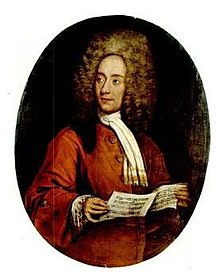Tomaso Albinoni
Tomaso Albinoni | |
|---|---|
 | |
| Born | June 8, 1671 |
| Died | January 17, 1751 (aged 79) Venice |
| Works | List of compositions by Tomaso Albinoni |
Tomaso Giovanni Albinoni (8 June 1671 – 17 January 1751) was an Italian composer of the Baroque era. His output includes operas, concertos, sonatas for one to six instruments, sinfonias, and solo cantatas.
Biography
Born in
In 1705, he married Margherita Rimondi; Antonino Biffi, the maestro di cappella of
Unlike most contemporary composers, he appears never to have sought a post at either a church or
Around 1740, a collection of Albinoni's
Music and influence

Most of his operatic works have been lost, largely because they were not published during his lifetime. However, nine collections of instrumental works were published. These met with considerable success and consequent reprints. He is therefore known more as a composer of instrumental music (99 sonatas, 59 concerti and 9 sinfonie) today. In his lifetime these works were compared favourably with those of
His instrumental music attracted great attention from
The famous Adagio in G minor, the subject of many modern recordings, is thought by some to be a musical hoax composed by Remo Giazotto. However, a discovery by musicologist Muska Mangano, Giazotto's last assistant before his death, has cast some doubt on that belief. Among Giazotto's papers, Mangano discovered a modern but independent manuscript transcription of the figured bass portion, and six fragmentary bars of the first violin, "bearing in the top right-hand corner a stamp stating unequivocally the Dresden provenance of the original from which it was taken". This provides support for Giazotto's account that he did base his composition on an earlier source.[8]
References
- Citations
- ISBN 978-0198691372.
- ^ a b c Tomaso Giovanni Albinoni at the Encyclopædia Britannica
- ^ "Tomaso Albinoni: Adagio in G minor".
- ^ Giazotto, Remo (1945) Tomaso Albinoni : musico di violino dilettante veneto : (1671–1750) : con il catalogo tematico delle musiche per strumenti, 197 esempi musicali e 14 tavole fuori testo; Milano : F.lli Bocca.
- ^ .Michael Talbot, "Tomaso Albinoni", Grove Music On-line. Oxford Music On-line, http://www.oxfordmusiconline.com/subscriber/article/grove/music/00461 (accessed 30 December 2011).
- ^ a b "Baroque Composers and Musicians: Tomaso Albinoni".
- ^ George J. Buelow, A history of baroque music, Indiana University Press, 2004, p. 467.
- ^ Nicola Schneider, "La tradizione delle opere di Tomaso Albinoni a Dresda", tesi di laurea specialistica (Cremona: Facoltà di musicologia dell'Università degli studi di Pavia, 2007): pp. 181–86.
- Bibliography
- Eleanor Selfridge-Field, Venetian Instrumental Music, from Gabrieli to Vivaldi. New York, Dover Publications, 1994. ISBN 0-486-28151-5
- Michael Talbot: "Tomaso Albinoni", Grove Music Online ed. L. Macy (Accessed June 25, 2005), (subscription access) Archived 2008-05-16 at the Wayback Machine
- Franco Rossi: Catalogo Tematico delle composizioni di Tomaso Albinoni Tomo I – Le 12 opere strumentali a stampa – edition "I Solisti Veneti", Padova 2002
- Franco Rossi: Catalogo Tematico delle composizioni di Tomaso Albinoni Tomo II – Le opere strumentali manoscritte – Le opere vocali – I libretti – edition "I Solisti Veneti", Padova 2003
External links
- Free scores by Albinoni at the International Music Score Library Project (IMSLP)
